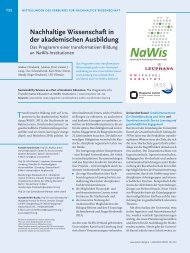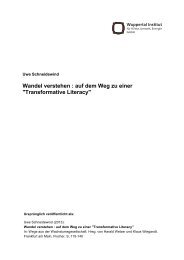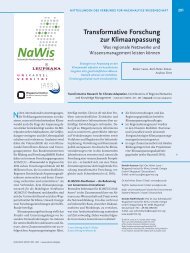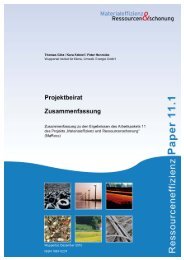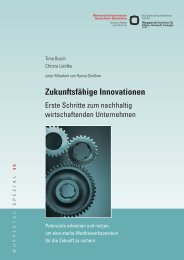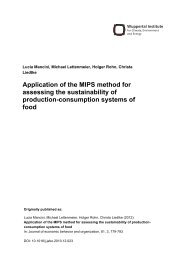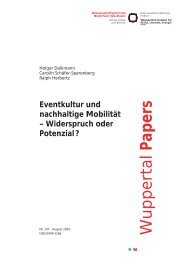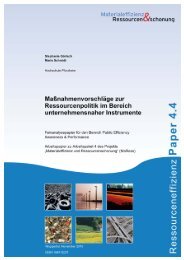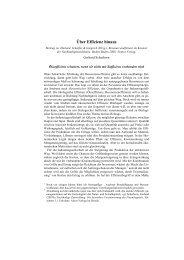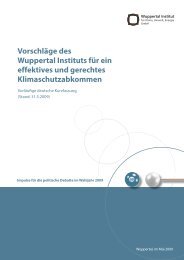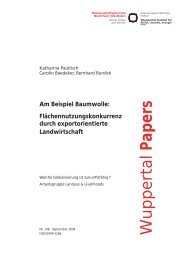Resource Efficiency Atlas - Publication Server of the Wuppertal ...
Resource Efficiency Atlas - Publication Server of the Wuppertal ...
Resource Efficiency Atlas - Publication Server of the Wuppertal ...
Create successful ePaper yourself
Turn your PDF publications into a flip-book with our unique Google optimized e-Paper software.
Effects Region and Country<br />
Material<br />
Water m 2<br />
Energy<br />
Surface<br />
fields<br />
Europe<br />
Austria<br />
<strong>Resource</strong> <strong>Efficiency</strong><br />
The resource requirements decrease considerably when<br />
using renewable primary products and minimal fossil and<br />
mineral materials. The production <strong>of</strong> <strong>the</strong> straw wall causes<br />
a clearly lower ecological footprint than a comparable conventional<br />
wall construction, which has an up a ten times<br />
larger ecological footprint. Also <strong>the</strong> low energy demand <strong>of</strong><br />
<strong>the</strong> S-HOUSE is noteworthy. An annual energy consumption<br />
<strong>of</strong> 6 kWh/m² is reached by an optimal insulation and<br />
<strong>the</strong> use <strong>of</strong> passive house technologies. This is significantly<br />
lower than <strong>the</strong> demanding standard for passive houses (15<br />
kWh/m2 ).<br />
Barriers and Risks<br />
Components and measures for resource-efficient econom-<br />
ic activities in <strong>the</strong> building industry are already used on<br />
a large scale. Never<strong>the</strong>less, by a combination <strong>of</strong> different<br />
attempts fur<strong>the</strong>r research and development is required to<br />
realise efficient system solutions with low expenditures. For<br />
this purpose available databases <strong>of</strong> primary products have<br />
to be adapted to <strong>the</strong> requirements <strong>of</strong> <strong>the</strong> building industry.<br />
According to <strong>the</strong> differing demands in regards to building<br />
types coordinated work flow and communication processes<br />
have to take place between involved actors like architects,<br />
craftsmen and engineers. So far instead <strong>of</strong> finished<br />
modules individual solutions are used, which lead to higher<br />
costs. Fur<strong>the</strong>rmore, high initial investments can arise and<br />
building restrictions can complicate <strong>the</strong> implementation.<br />
The insulating effect and <strong>the</strong> reaction <strong>of</strong> straw to fire were<br />
tested in comprehensive preliminary studies. However,<br />
prejudices concerning deficient structural-physical attributes<br />
are prevalent.<br />
Potentials<br />
Higher requirements for old and new buildings on federal<br />
and EU level such as, for example, energy saving regulations<br />
and comprehensive supporting possibilities, will lead<br />
to an increase in renovation and new building construction.<br />
Reduction <strong>of</strong> energy demand to a tenth compared<br />
with today’s best available technology and use <strong>of</strong> renewable<br />
primary products may lead to a widespread dispersal<br />
<strong>of</strong> this building technology based on renewable products,<br />
while energy and primary product costs are increasing.<br />
Fur<strong>the</strong>r information<br />
GrAT-Gruppe Angepasste Technologie<br />
Wiedner Hauptstraße 8-10<br />
1040 Wien, Austria<br />
contact@grat.at<br />
www.grat.at<br />
Ressourceneffizienzatlas<br />
<strong>Resource</strong> <strong>Efficiency</strong> <strong>Atlas</strong> 57



